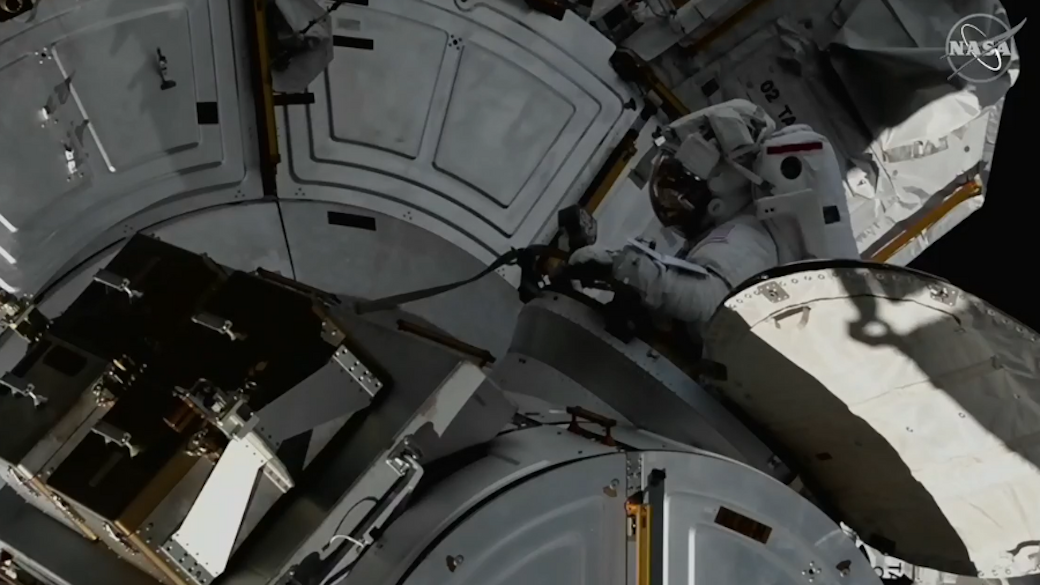
NASA Astronaut Josh Cassada enters the airlock at the end of the Nov. 15 spacewalk to prepare the space station for upcoming solar array upgrades.
HOUSTON—NASA astronauts Josh Cassada and Frank Rubio resumed the agency’s efforts to upgrade the International Space Station’s (ISS) solar power-generation system with a 7-hr. spacewalk on Nov. 15 to prepare the starboard end of the long solar-power truss for the installation of ISS Roll Out Solar Arrays (iROSAs).
The two first-time spacewalkers focused their hand-intensive activities on the installation of new power cables and a set of support struts and brackets called a Mod Kit to prepare for the planned arrival next year of a final pair of iROSAs.
Cassada and Rubio—members of the seven-person U.S., Russian and Japanese Expedition 68 ISS crew—got a late start due to difficulties activating spacesuit video displays.
Once the difficulties were overcome, the duo began a hand-over-hand, handrail trek from the U.S. Quest airlock to their worksite at the starboard end of the 300-ft.-long power truss.
The spacewalk was the first by NASA since it suspended excursions in the aftermath of a March 23 outing in which a thin layer of water formed on European Space Agency astronaut Matthias Maurer’s NASA spacesuit helmet visor at the conclusion of a spacewalk. NASA lifted the ban Oct. 18 after results of an investigation showed the visor condensation was a consequence of “crew exertion” and a responsive adjustment of the suit’s thermal control setting by Maurer.
Changes in procedure were instituted that included closer monitoring of thermal control settings by NASA flight controllers. The helmets also were equipped with additional absorption bands to capture condensation that could form from cooling water that circulates through astronauts’ undergarments.
The issue did not repeat during the Nov. 15 spacewalk for the installation of Mod Kit hardware that arrived at the ISS aboard Northrop Grumman’s 18th NASA-contracted Cygnus resupply mission on Nov. 9.
Rubio initiated a list of spacewalk tasks by routing a power cable to the 3A channel. He then joined Cassada for the installation of Mod Kit hardware at the 1B power channel mast canister.
The 3A channel had been equipped with Mod Kit hardware during a previous spacewalk. They skipped a planned second cable installation at the 1B power channel and some fastener installation activities at the worksite due to the more than hour-long delay in the start of their spacewalk and limitations on use of the spacesuits.
The first pair of iROSAs, each capable of generating 20 kW of solar power, were installed with NASA spacewalks in June 2020 at the 2B and 4B power channels on the opposite, or port, end of the truss. In all, NASA and ISS operations prime contractor Boeing intend to upgrade six of the station’s eight original solar-array power channels with IROSAs, which once installed each will unfurl out to a distance of 60 ft. with a width of 20 ft.
Planned for launch from NASA’s Kennedy Space Center on Nov. 21 at 4:19 p.m. EST, SpaceX’s 26th NASA-contracted resupply mission is to deliver two more iROSAs among its cargo of crew supplies, scientific research and technology development equipment, and station hardware. Those are to be installed with NASA spacewalks planned for Nov. 29 at the 3A power channel on the starboard truss and Dec. 3 at the 4A power channel on the port truss.
Both the 3A and 4A channel-support structures previously were modified with kits for the arrival of their iROSAs aboard the SpaceX Dragon cargo capsule planned for Nov. 23.
When complete, the multiyear ISS solar-power system upgrade is expected to provide adequate electricity for ISS operations through its third decade, which is planned to conclude with a destructive deorbit at the end of 2030. Launched between December 2000 and March 2009, the original complement of eight solar arrays had 15-year design lives.
Though degrading, the original arrays continue to generate electricity in support of daily life aboard the station and the research and operational infrastructure functions provided by Canada, Europe, Japan, Russia and the U.S.
The iROSA upgrade, which is to boost overall solar-power generation to 215 kW from 160 kW, is intended to support growing research and technology interest in the ISS by NASA and its partner space agencies as well as from academia, the commercial sector and other government agencies through their ISS U.S. National Laboratory eligibility.
The current ISS research and technology agenda includes 294 projects with themes that range from astrophysics and Earth observation to advances in spacecraft life-support system development, the monitoring of human health and efforts to address disease and other ailments with new medications, and the cultivation of human tissues and organs transplant.

Comments